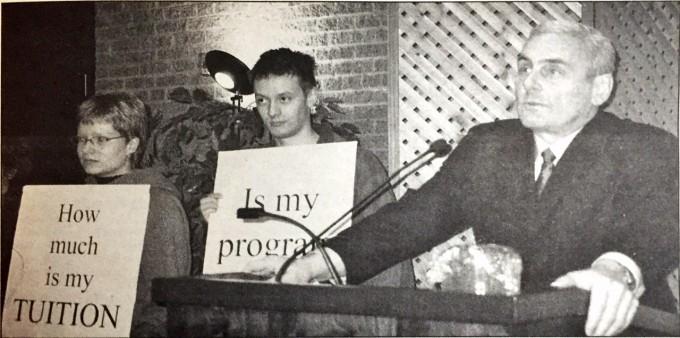By Jordan Heath-Rawlings
Claude Lajeunesse tuned out the kazoos and concentrated on Ryerson.
The president soldiered through his State of the University address on Monday, despite interruptions from a posse of students who said they are concerned about affordable education.
Moments after Lajeunesse began his yearly rehashing of Ryerson’s accomplishments and challenges, about 15 students holding placards protesting cuts and tuition hikes took their place in a line behind him.
“Gee, I have a cheering section,” joked the president.
One of the protesters, wearing an anti-tuition hike poster across his chest and another on his head, proffered a petition demanding affordable education to Lajeunesse.
The president stood at the podium with his arms crossed, refusing to sign.
“I think you have something to say,” he told the students, and offered the microphone to Alex Lisman, RyeSAC v.p. education.
Lisman used the impromptu platform to make what he called “the real state of the university address,” citing problems with tuition increases, curriculum cuts and reduced course hours as well as other issues.
“We feel ashamed to be at a university that is unable to find adequate prayer space for Muslim students,” Lisman told the crowd composed mainly of Ryerson staff, faculty and students.
Once Lisman finished, nearly all the students present rose to stand with the protesters.
Then, Lajeunesse began his speech in earnest.
“There is no quick fix,” Lajeunesse said of the funding disparities facing Ryerson. “There is no magic solution.”
Lajeunesse said that a main problem with Ryerson funding is that the university receives a lot of money from corporate and private backers, most of it coming with strings attached.
“We welcome new sources of funding,” Lajeunesse said, “But it almost never arrives without specific instructions on how it is to be spent.”
Much of Lajeunesse’s speech was met with interruptions from the 50 students standing behind him.
“And another pay raise for you, huh Claude?” a heckler shouted as Lajeunesse outlined his plans for Ryerson’s future.
“Hope so,” answered the president, sparking cheers from the audience in front of him, and enraged kazoo tooting from the students behind him.
Periodically throughout the speech, the protesters serenaded Lajeunesse with their own version of the Pink Floyd song Another Brick in the Wall.
“Hey, Claude, leave our school alone,” they sang.
Lajeunesse tried to cite positive statistics about Ryerson enrolment, and was met by wisecracks from the protesters at every turn.
“In 2001, we received 36,000 undergraduate student applications,” Lajeunesse said.
“How many from lower income families?” one student called out.
“How many have dropped out already?” called another.
After the speech, Lisman said he was troubled by Lajeunesse’s crack about a pay raise, a joke Lisman believes was serious.
“It’s just disgusting to me that he can stand there and appear concerned about the budget cuts and tuition increases and then gladly accept a pay raise.”
“He’s quite serious about (the raise),” Lisman said. “And that will come at the expense of the programs and the students.”
Lajeunesse’s speech, slightly drawn out from the interruptions, touched on all the accomplishments of the Ryerson community. The president focused on the achievements of several professors, the new additions to the library’s digital database and the four new buildings currently under various stages of development. Most the audience seemed sympathetic toward the disruptions and Lajeunesse was well received by the administration, especially considering the circumstances.
“Demonstrations are demonstrations. They are not seminars,” said Ryerson v.p. Academic Errol Aspevig afterwards. “(The president) did a good job.”
Lisman said that despite Claude calling him out as the groups “leader,” the protest at the address was not a RyeSAC event.
“Claude tried to single out (RyeSAC) individuals,” Lisman said. “But that’s only because he remembers our names.”
“All the ideas came from a diverse group of students who are just starting to organize for Feb. 6 (the student day of action).”











Leave a Reply